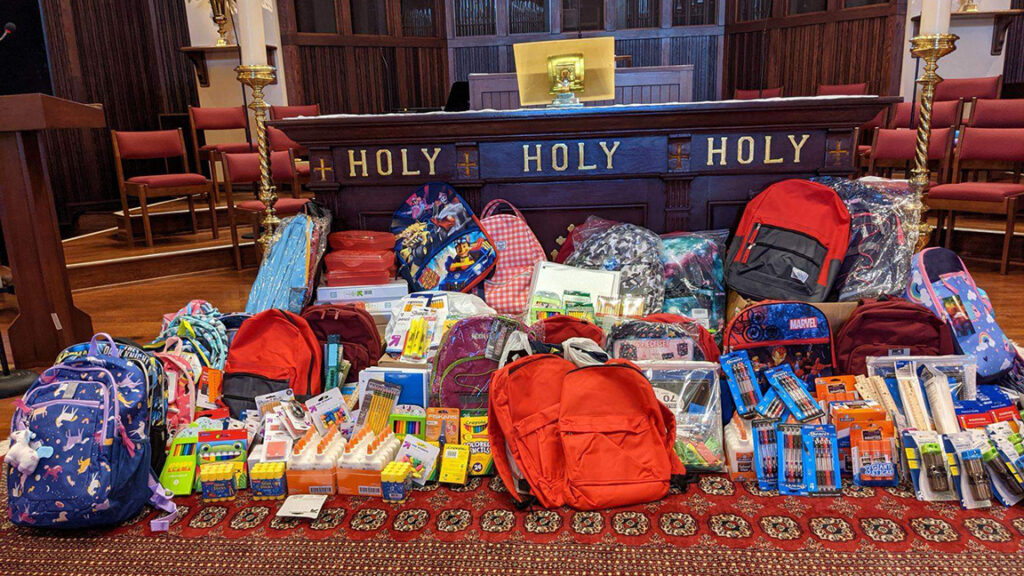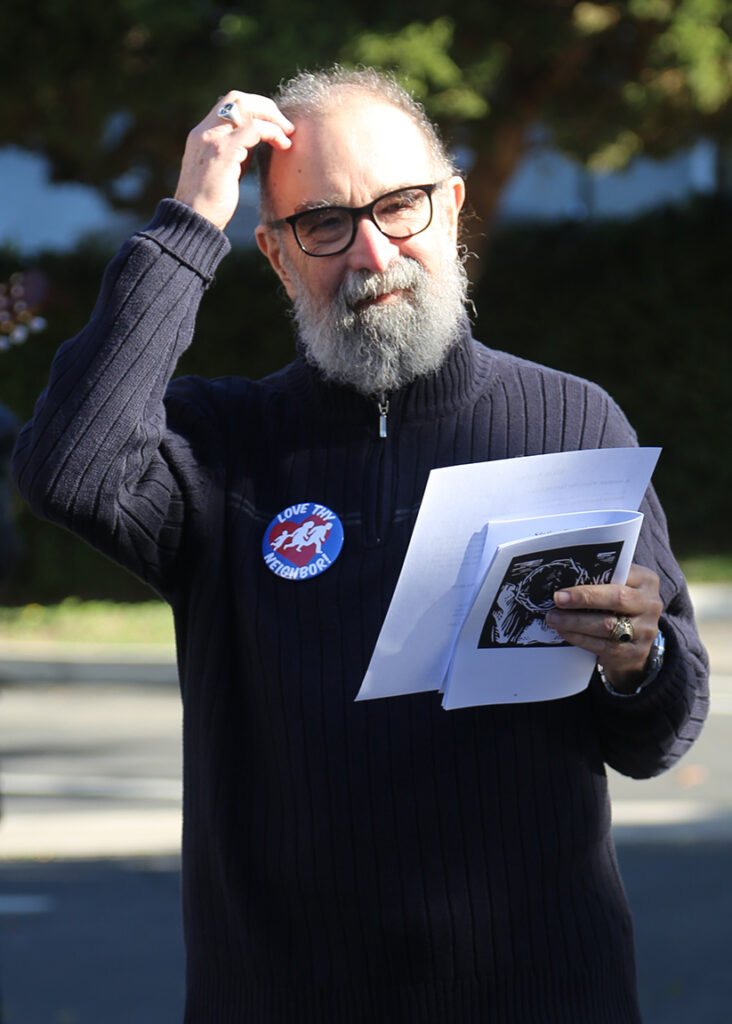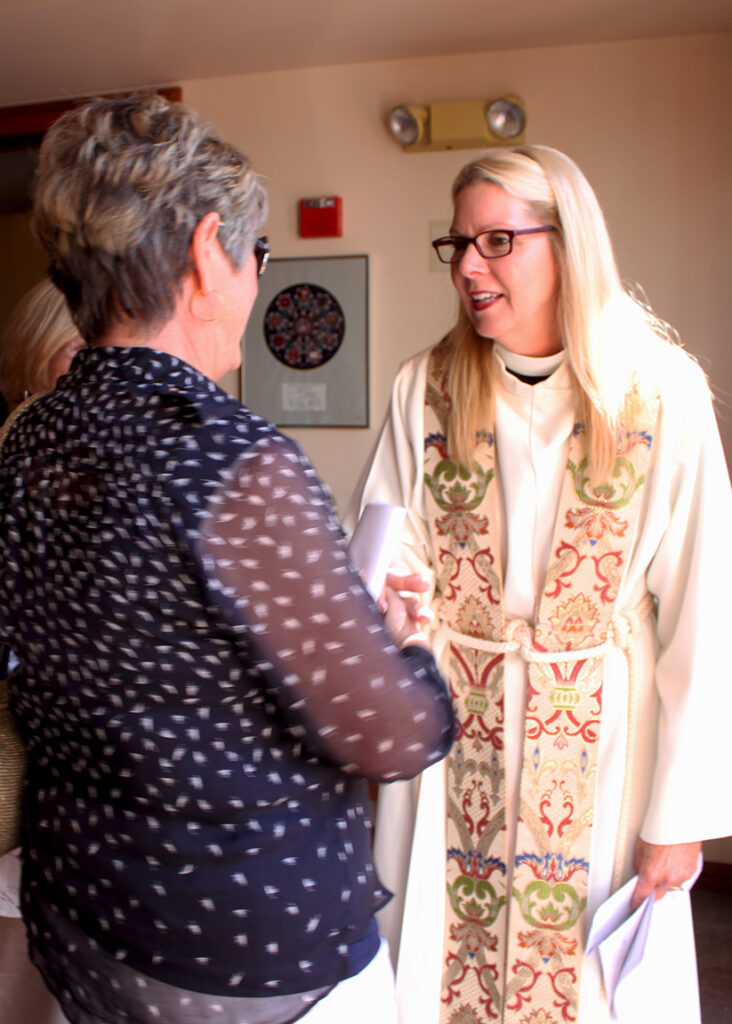
St. James’ Church, Newport Beach, collected school supplies for young members of its sister congregation, St. Michael’s in Anaheim, at the beginning of the 2021-22 school year. Courtesy photo
[The Episcopal News] As churches reimagine post-pandemic ministry, two Southland congregations hope a budding relationship will blossom into a full-fledged cross-cultural exchange.
For the Rev. Juan Jimenez, vicar of St. Michael’s Church in Anaheim, a bond forged with St. James’ Church in Newport Beach at the height of COVID-19 centered around “a goal to create some personal relationships between people in both congregations that would allow us to understand each other better. In this society, we really need that, and we need that in the church,” he said.
“We are two very different congregations, but we’re all members of the Body of Christ – and yet we’re all so different.”
Pre-COVID, Jimenez, 76, had led four Sunday worship services – two in Spanish and two in English, for about 400 congregants. The English-language services were intended for second- and third-generation Latinos, he said.
The pandemic decimated the congregation; at least 14 members died, many more became ill while others – employed in the service industry and by the Disneyland Resort – lost their jobs when restaurants and entertainment venues closed. Challenges continue to mount for many, since the eviction moratorium for renters ended Sept. 30, he said.

Juan Jiménez, pictured here at a “Called to the Wall” pilgrimage, is vicar of St. Michael’s Church in Anaheim. Photo: Janet Kawamoto
In Newport Beach, some 20 miles away but a world apart, about 9% of the population is Latino, compared to Anaheim’s 54%. Anaheim’s 2019 per-capita income was $28,465. About 24% of Anaheim residents are white, compared to 80% in Newport Beach, which boasted a 2019 per-capita income of $95,404.
“I was serving on the Program Group on Mission Congregations and heard St. Michael’s was struggling financially, yet was a thriving parish with an ASA of 400-plus,” said the Rev. Canon Cindy Evans Voorhees, St. James’ vicar. “Then the weight of the pandemic hit about 80% of the congregation with cuts in the service industry where they worked. I felt St. James would respond to their circumstances, and they did. I proposed the sister congregation relationship to Fr. Juan, and then to my congregation, in the fall of 2020. All were in agreement – we were in this together.”
Los Angeles Bishop Suffragan Diane M. Jardine Bruce facilitated the partnership, which has since evolved into both mutual moral support as well as financial and other assistance, Jimenez said.
“God was probably behind it,” he added. “Financially, they are helping with $1,000 a month, it’s a lifesaver. In other ways, at the beginning of the school year they donated backpacks and school supplies for our kids. That was very helpful.”
Voorhees said what began as a desire to help St. Michael’s quickly progressed into a bond of mutual support “that has become really important to both Fr. Juan and me now.”
The two congregations were also linked through mutual loss and grief, she said.

Cindy Voorhees greets members after a service at St. James’ Church, Newport Beach, where she serves as vicar. Photo: Janet Kawamoto
“St. James had a death a week from the end of October 2020 to the end of January 2021,” Voorhees recalled. “There were three suicides and an infant death.” Turning to Jimenez for collegial friendship and support was beneficial, she said.
“Some of the key values of St. James are being in community, inclusivity, loving our neighbor, and serving Christ,” she added. “We try to live out these values in our local, national, and international world. St. Michael’s has been especially important to St. James as a local neighbor who is part of our Episcopal family. We have grown in many ways from the relationship by including St. Michael’s in our spiritual journey and hopefully they have too.”
Bruce said the pairing is a wonderful example of collaborative ministry.
“One of the joys of my work as a bishop has been connecting people who might not otherwise know about each other’s ministry,” Bruce said in an email to The Episcopal News. “This was the case with St. Michael’s and St. James’. Having had conversations with both Fr. Jimenez and Canon Voorhees, I saw the Spirit moving – and I could see the great benefit for both congregations collaborating together and sharing their many gifts and skills. It was a blessing to introduce the two congregations through their talented and gifted clergy.”
“This type of collaborative ministry allows both congregations to grow individually and together – each sharing their unique gifts of time, talent and treasure. I saw this type of collaboration work extremely well in the Philippines – where the byproduct of the collaboration was the deepening and strengthening of ministries in both congregations AND their growth in membership of each of the churches. St. Michael’s and St. James are a wonderful example in this diocese of how this pairing can and should be done.”
There are plans for a pulpit exchange, joint worship services, a summer fiesta, and other activities to foster understanding among the congregations. St. James continues to contribute $1,000 a month to St. Michael’s and plans to continue the practice in 2022, Voorhees said.
“I would like to encourage other churches – even if they only give $100 a month, that would be $1,200 a year and it would help.”
Voorhees’ expertise as an architect and general contractor came in handy during preliminary conversations as Habitat for Humanity explored the possibility of erecting affordable housing on the church’s property.
“They (Habitat) are looking at some viable opportunities there. It’s just in the beginning stages, but they are thinking it could be a win-win for both the church and for Habitat. it’s been fun to work with each other.”
“The bottom line is, we felt called to help and we wanted a sister relationship and so far it’s worked out really well,” Voorhees said. “We wish we could get COVID behind us so we could do a little more. I would like to encourage other churches to consider this.”
Jimenez agreed. “The future of the church depends on partnering together as the Body of Christ. That’s what we do to help each other, and give to the body whatever gifts have been given to us. That is the way the church is going to grow. We live in such a fragmented society; the church is fragmented. If we cannot get our act together, we are in big trouble.”
